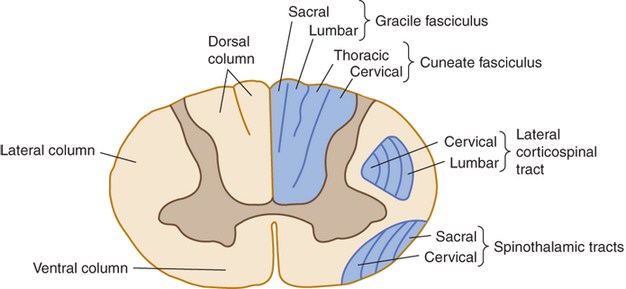
This is the ascending tract passing through dorsal white column of spinal cord for which it is so called. Dorsal white column or posterior funiculus is made up of this ascending tract which is ipsilateral in nature. Dorsal column transmits following sensory informations.
- Exteroceptive: Discrimination touch with the help of ability to localize two points touched very closely on the body surface.
- Proprioceptive: Sense of position and movements from muscles and joints, and vibration sense.
Discriminative touch (and pressure also) sensation is carried from peripheral receptors to the spinal cord through its posterior nerve root. Primary sensory neurons carrying this exteroceptive sensation are called long primary sensory neurons because their axons, i.e. central process of the posterior root ganglia cells, do not form synaptic connection with spinal sensory neurons. They pass vertically upwards through the posterior funiculus to form the dorsal column tract.
Short primary sensory neurons carrying vibration sense and sense of position and movements from muscles and joints relay in tract cell in Clerke’s column and other cell group of laminae IV to VI. Axons of these second order neuron ascend through posterior column to take part in formation of dorsal column tract along with axons of long primary sensory neurons carrying discriminative touch (and also pressure to some extent).
So, it is clear from above description that, dorsal column tract is formed by axons of two different kinds as follows.
- Axons of long primary sensory neurons carrying sensory impulse for discriminative touch and pressure.
- Axons of tract neurons from Clarke’s column and other sensory neurons of lamina IV to VI carrying impulse for sense of position and movements and also vibration sense.
Fiber tracts of dorsal column carrying sensory impulse from lower half of body (below midthoracic level), entering through lower group of spinal nerves, are placed in the medial part of posterior funiculus. It is called fasciculus gracilis. It is superadded by similar kind of fiber bundle which enter the spinal cord carrying similar sensation from upper half of body (above midthoracic level). These fiber bundles of dorsal column ascend through lateral part of posterior funiculus lateral to medially placed fasciculus gracilis.
It is called fasciculus cuneatus. It is demarcated from fasciculus gracilis by intermediolateral septum.Both kinds of fibers of fasciculus gracilis and fasciculus cuneatus, i.e. axons of long primary sensory neurons as well as those of tract neurons of lamina IV to VI, relay in nucleus gracilis and nucleus cuneatus in posterior part of lower half of medulla oblongata. Posterior surface of lower half of medulla oblongata presents two round bulge known as gracile tubercle and cuneate tubercle beneath which lies corresponding nucleus.
Source: Easy and Interesting Approach to Human Neuroanatomy (Clinically Oriented) (2014)